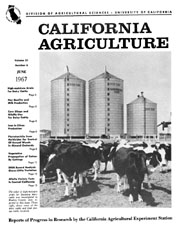


University of California
California Agriculture
|
|||
|
|||

The value of high-moisture grain for lactating dairy cattle was investigated in Madera County tests reported in this issue. Photo right, shows some of the dairy cattle and feed storage tanks involved.
June 1967
Volume 21, Number 6 |
|||
|
University of California, 1301 S. 46th St., Bldg. 478 Richmond, CA
|